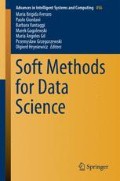Abstract
In order to overcome the problems due to the unboundedness of the likelihood, constrained approaches to maximum likelihood estimation in the context of finite mixtures of univariate and multivariate normals have been presented in the literature. One main drawback is that they require a knowledge of the variance and covariance structure. We propose a fully data-driven constrained method for estimation of mixtures of linear regression models. The method does not require any prior knowledge of the variance structure, it is invariant under change of scale in the data and it is easy and ready to implement in standard routines.
Access this chapter
Tax calculation will be finalised at checkout
Purchases are for personal use only
References
Biernacki C (2004) An asymptotic upper bound of the likelihood to prevent Gaussian mixtures from degenerating. Technical Report, Université de Franche-Comté
Biernacki C, Chrétien S (2003) Degeneracy in the maximum likelihood estimation of univariate Gaussian mixtures with the EM. Stat Probab Lett 61:373–382
Chen J, Tan X, Zhang R (2008) Inference for normal mixtures in mean and variance. Statistica Sinica 18(2):443
Ciuperca G, Ridolfi A, Idier J (2003) Penalized maximum likelihood estimator for normal mixtures. Scand J Stat 30(1):45–59
Day NE (1969) Estimating the components of a mixture of two normal distributions. Biometrika 56:463–474
Dempster AP, Laird NM, Rubin DB (1977) Maximum likelihood from incomplete data via the EM algorithm. J R Stat Soc: Ser B (Stat Methodol) 39:1–38
DeSarbo WS, Cron WL (1988) A maximum likelihood methodology for clusterwise linear regression. J Classif 5(2):249–282
Eggermont PPB, LaRiccia VN (2001) Maximum penalized likelihood estimation, vol 1. Springer, New York
Gallegos MT, Ritter G (2009) Trimmed ML estimation of contaminated mixtures. Sankhya: Indian J Stat Ser A (2008-):164–220
García-Escudero LA, Gordaliza A, Matran C, Mayo-Iscar A (2008) A general trimming approach to robust cluster analysis. Ann Stat 36:1324–1345
García-Escudero LA, Gordaliza A, San Martń R, Van Aelst S, Zamar R (2009) Robust linear clustering. J R Stat Soc: Ser B (Stat Methodol) 71(1):301–318
García-Escudero LA, Gordaliza A, Mayo-Iscar A, San Martń R (2010) Robust clusterwise linear regression through trimming. Comput Stat Data Anal 54(12):3057–3069
Green PJ (1990) On use of the EM for penalized likelihood estimation. J R Stat Soc: Ser B (Stat Methodol) 443–452
Hathaway RJ (1985) A constrained formulation of maximum-likelihood estimation for normal mixture distributions. Ann Stat 13:795–800
Hennig C (2000) Identifiablity of models for clusterwise linear regression. J Classif 17(2):273–296
Huber PJ (1967) The behavior of maximum likelihood estimates under nonstandard conditions. In: Proceedings of the fifth Berkeley symposium on mathematical statistics and probability, vol 1, no 1, pp 221–233
Huber PJ (1981) Robust statistics. Wiley, New York
Ingrassia S (2004) A likelihood-based constrained algorithm for multivariate normal mixture models. Stat Methods Appl 13:151–166
Ingrassia S, Rocci R (2007) A constrained monotone EM algorithm for finite mixture of multivariate Gaussians. Comput Stat Data Anal 51:5339–5351
Kiefer NM (1978) Discrete parameter variation: efficient estimation of a switching regression model. Econometrica 46:427–434
Kiefer J, Wolfowitz J (1956) Consistency of the maximum likelihood estimator in the presence of infinitely many incidental parameters. Ann Math Stat 27:886906
McLachlan GJ, Peel D (2000) Finite mixture models. John Wiley and Sons, New York
Quandt RE (1972) A new approach to estimating switching regressions. J Am Stat Assoc 67(338):306–310
Quandt RE, Ramsey JB (1978) Estimating mixtures of normal distributions and switching regressions. J Am Stat Assoc 73(364):730–738
Ritter G (2014) Robust cluster analysis and variable selection. Monographs on statistics and applied probability, vol 137. CRC Press
Snoussi H, Mohammad-Djafari A (2001) Penalized maximum likelihood for multivariate Gaussian mixture. In: Fry RL (ed) MaxEnt workshops: Bayesian inference and maximum entropy methods. pp 36–46, Aug 2001
Seo B, Kim D (2012) Root selection in normal mixture models. Comput Stat Data Anal 56:2454–2470
Tan X, Chen J, Zhang R (2007) Consistency of the constrained maximum likelihood estimator in finite normal mixture models. In: Proceedings of the American Statistical Association, American Statistical Association, Alexandria, VA, 2007, pp 2113–2119 [CD-ROM]
Xu J, Tan X, Zhang R (2010) A note on Phillips (1991): “A constrained maximum likelihood approach to estimating switching regressions”. J Econom 154:35–41
Author information
Authors and Affiliations
Corresponding author
Editor information
Editors and Affiliations
Rights and permissions
Copyright information
© 2017 Springer International Publishing Switzerland
About this paper
Cite this paper
Di Mari, R., Rocci, R., Gattone, S.A. (2017). Finite Mixture of Linear Regression Models: An Adaptive Constrained Approach to Maximum Likelihood Estimation. In: Ferraro, M., et al. Soft Methods for Data Science. SMPS 2016. Advances in Intelligent Systems and Computing, vol 456. Springer, Cham. https://doi.org/10.1007/978-3-319-42972-4_23
Download citation
DOI: https://doi.org/10.1007/978-3-319-42972-4_23
Published:
Publisher Name: Springer, Cham
Print ISBN: 978-3-319-42971-7
Online ISBN: 978-3-319-42972-4
eBook Packages: EngineeringEngineering (R0)

